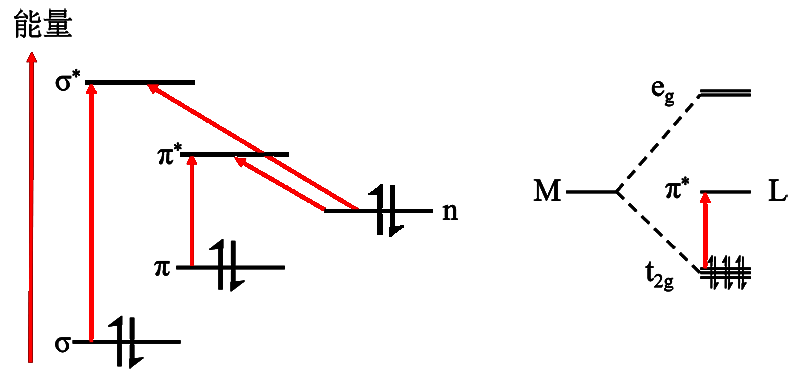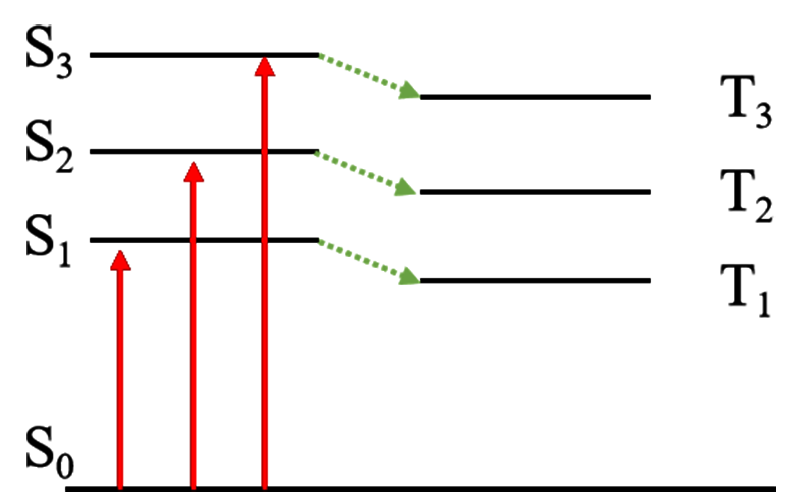Original work is not easy, if you want to reproduce this article, please contact the staff and indicate the source of the reproduced article, otherwise, it will be treated as copyright infringement!
Organic photochemical reactions involve the absorption of light, excitation, and chemical reactions, making it an interdisciplinary study at the intersection of chemistry and physics. Unlike thermal reactions, it is an excited-state reaction. Molecular excitation states are complex mixed states, and to understand the principles of organic photochemical reactions, one needs to first understand the properties of molecular excitation states after the absorption of photons.
Principles of Excited-State Molecular Generation
Molecular excitation can be categorized into rotational, vibrational, and electronic excitations.
The transition of molecules from their ground state to an excited state through the absorption of light falls under the category of electronic excitation.
According to molecular orbital theory, when atoms combine to form molecules through covalent bonds, they create bonding orbitals (σ, π), anti-bonding orbitals (σ*, π*), and non-bonding orbitals (n). In organic molecules in their ground state, electrons primarily occupy lower-energy bonding orbitals and non-bonding orbitals, while anti-bonding orbitals remain unoccupied.
σ orbitals correspond to single bonds, where orbitals overlap extensively, resulting in lower orbital energy and stronger single bond energy;
π orbitals correspond to double or triple bonds, primarily overlapping side by side, with some orbital overlap, resulting in slightly higher orbital energy;
n orbitals correspond to lone pairs of electrons in heteroatoms like N, S, O, and retain energy levels similar to atomic orbitals.
As shown in Figure 1, when an organic molecule in its ground state absorbs light, electrons from both bonding and non-bonding orbitals can be excited to the anti-bonding orbitals, forming excited-state molecules. In the majority of organic photochemical reactions, transitions occur through n→π* and π→π* transitions, corresponding to absorption wavelengths in the visible and ultraviolet regions, respectively.
For metal-organic complex photocatalysts such as iridium complexes with bipyridine ligands, based on crystal field theory, the 5 d orbitals of the Ir3+ ion split into three lower-energy t2g orbitals and two higher-energy eg orbitals under the octahedral field of the ligands. Ir3+ fills its t2g orbitals with six electrons, leaving the eg orbitals empty. Because the π* anti-bonding orbitals of the ligands lie between the t2g and eg orbitals, when the molecule absorbs photons, electrons from the t2g orbitals transition to the ligand's π* anti-bonding orbitals, facilitating M→L electron transfer[1].

Figure 1: Schematic representation of the electron excitation process after light absorption by organic molecules (left) and metal-organic complex molecules (right).
Rules for Excited-State Molecular Generation
Four fundamental rules must be followed during the electronic excitation process of molecule absorption of photons.
1. Spin-forbidden rule: Electrons on bonding or non-bonding orbitals consist of electron pairs with opposite spins. When they transition, their spin direction remains unchanged.
2. Symmetry-forbidden principle: Molecules with orbitals that possess a symmetry center can only undergo transitions that preserve symmetry, such as the case with ethylene molecules, where π orbitals are symmetric and π* orbitals are anti-symmetric, allowing π→π* transitions.
3. Frank-Condon principle: Immediately after an electron transition, the molecule retains the same geometry as before the transition.
4. Orbital overlap rule: Electron transitions involve two orbitals that must overlap spatially, meaning they occupy the same region in space. Transitions can only occur when such overlap exists, such as σ orbitals along the bond axis and π orbitals perpendicular to it, allowing σ→σ* and π→π*-transitions but not σ→π* or π→σ* transitions.
Based on the above rules, when organic molecules absorb photons and transition to excited states, one electron from a pair is excited to a higher-energy orbital, resulting in two single electrons. Since the spin direction of the excited electrons remains unchanged, there is a certain probability that the excited-state molecules, with two electrons of the same spin direction, will lose some energy through intersystem crossing and become excited-state molecules with two electrons of the same spin direction, following Hund's rules.
Classification of Excited-State Molecules and Reaction Forms
Different states of excited-state molecules are typically distinguished using multiplicities and energy levels.
When excited-state molecules are placed in a magnetic field of appropriate intensity, the spectral lines in their atomic absorption and emission spectra split. The number of line splittings defines the multiplicity. Spectral lines for excited states with opposite electron spins correspond to singlet multiplicity S, while those with the same electron spins correspond to triplet multiplicity T. In most ground-state molecules, except for dioxygen, the number of spectral lines is 1, so the ground state is typically denoted as S.
Regarding energy levels, the ground state is defined as S₀, and the nearest lower-energy excited state is known as the first singlet excited state, denoted as S₁, while the corresponding triplet excited state is called the first triplet excited state, denoted as T₁, and so on, giving rise to S₂, S₃, T₂, T₃, and so forth. For example, after n→π*

Excited-state molecules have very short lifetimes, typically in the range of 10⁻⁹ to 10⁻³ seconds (singlet state: 10⁻⁹ to 10⁻⁵ seconds, triplet state: 10⁻⁵ to 10⁻³ seconds). After their generation, they rapidly release the absorbed light energy through physical processes or chemical processes.
Physical processes mainly include radiative processes (fluorescence and phosphorescence) and non-radiative processes (internal conversion, intersystem crossing, and vibrational relaxation), among others.
Chemical processes primarily include the following:
(1) Unimolecular photochemical reactions, where the excited molecule undergoes self-reactions, including photodissociation, rearrangement, and isomerization reactions;
(2) Bimolecular photochemical reactions, involving a reaction between an excited-state molecule and a ground-state molecule, such as cycloaddition and polymerization reactions;
(3) Photocatalytic reactions, where a photosensitizer or photocatalyst absorbs light and enters an excited state, initiating reactions in other compounds through processes like oxidation-reduction reactions or energy transfer, including photosensitization and photocatalytic oxidation-reduction reactions.
The above content is a translation and summary based on reference materials. If there are any errors, please feel free to correct them as my knowledge is limited.
[1] M. H. Shaw, J. Twilton and D. W. C. Macmillan*, Photoredox Catalysis in Organic Chemistry[J], Journal of Organic Chemistry, 2016, 81(16), 6898.